Project Management Knowledge Areas
In addition to the Project Process Groups, the PMI has defined 10 Project Knowledge Areas. Each one is defined by a set of processes, inputs, outputs, tools and techniques.
The 10 knowledge areas will be used most of the time across any project.
Smaller projects may not go into as much detail as larger scale projects but the foundations of success will remain the same and it all begins with these Project Knowledge Areas applied in practise across the Process Groups.
The 10 knowledge areas will be used most of the time across any project.
Smaller projects may not go into as much detail as larger scale projects but the foundations of success will remain the same and it all begins with these Project Knowledge Areas applied in practise across the Process Groups.

Download and open this PMBOK Summary map in MindGenius
1. Integration Management
The Project Management Institute define Project Integration Management as:
“the processes and activities to identify, define, combine, unify, and coordinate the various processes and project management activities within the project management process groups”
In simpler terms, integration management is about managing resources, balancing stakeholder demands, considering alternative approaches, selecting the working processes that meet the project objectives and managing dependencies among the different knowledge areas.
In project delivery, each of the processes followed will overlap and integration management is simply how to manage each of those overlapping processes in a way that meets stakeholder requirements and successful delivery of the finished project.

Download this Project Planning mind map in MindGenius
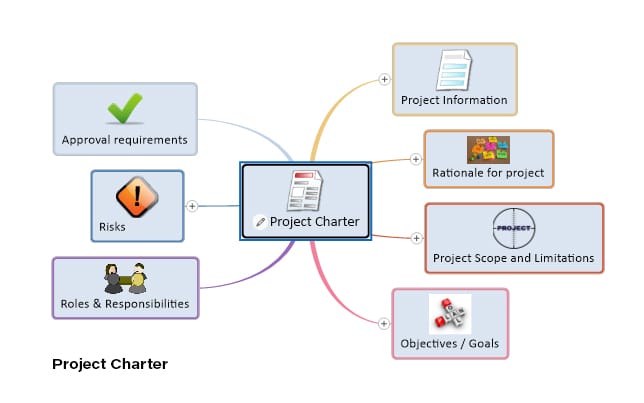
Download this Project Execution mind map in MindGenius
Develop Project Management Plan:
Once a project is given the go ahead and the Project Charter produced, the planning processes will begin. The result of which will be the creation of the Project Management Plan.
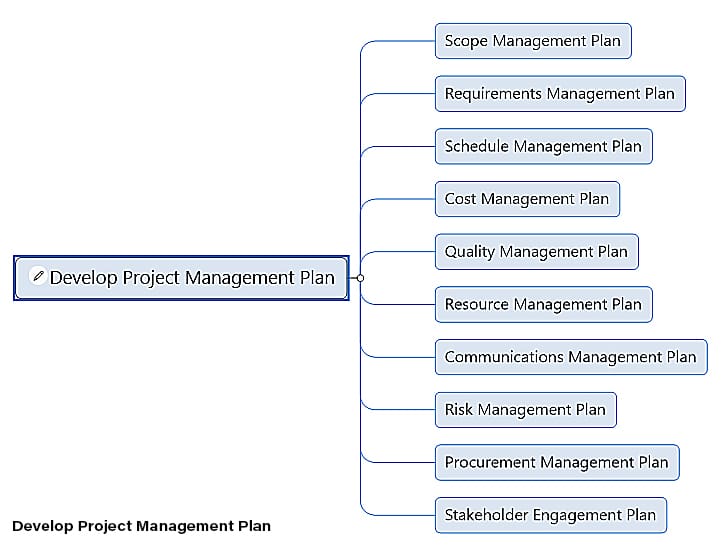
Direct and Manage Project Work:
Once planning is complete, the project manager and team begin working on the tasks identified in the plan which will result in the completion of the project. This will also include implementing any approved change requests.
Manage Project Knowledge:
A project depends on people in the team being knowledgeable on the work required to meet the objectives. Managing project knowledge means knowing what knowledge exists within the team and what gaps need to be filled through training to deliver the project.
Monitor and Control Project Work:
No project can stay on track without appropriate monitoring of activities to identify issues or bottlenecks or that equipment or materials aren’t available when they are needed. The processes of monitoring and control ensure performance is in line with the project plan.
Perform Integrated Change Control:
As a project progresses, change requests are likely to come in. Integrated change control is the process of managing these requests through review, approval and implementation as well as communicating the decisions throughout.
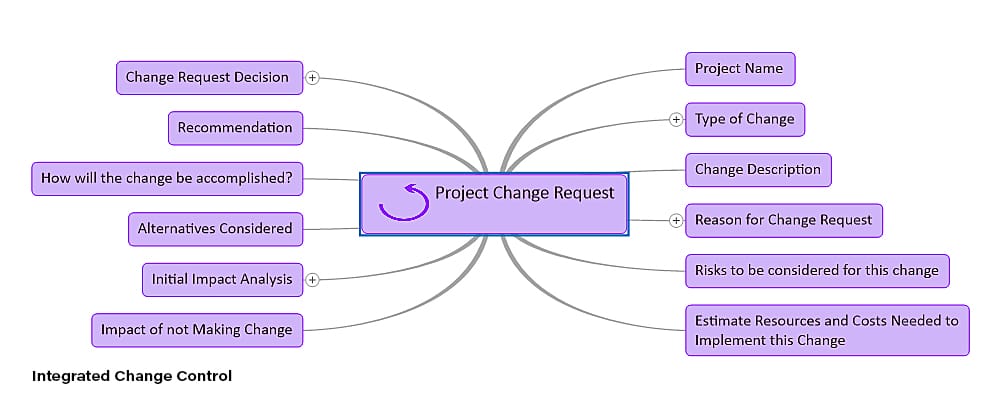
Download this Project Monitoring and Control Checklist in MindGenius
Close Project or Phase:
A project is complete when the deliverables are handed over and approved. Managing this process involves making sure any close out meetings are scheduled and final project documentation is brought up to date and complete.
Back to Knowledge Areas Menu
2. Project Scope Management
Project Scope Management refers to the actual work involved in the project and the process of managing scope will result in two key project documents, the Project Scope Statement and the Work Breakdown Structure (WBS).
Without a clear definition of the project scope and agreement on that scope, issues will undoubtedly arise which will have a negative impact on the project.
Project scope sets out what is included in the project and, equally important, what is not included. Clearly communicating the scope to all stakeholders ensures there is no debate over this at a later stage if questions arise as to why something wasn’t delivered – you can easily refer back to the original scope agreement to confirm what is right.
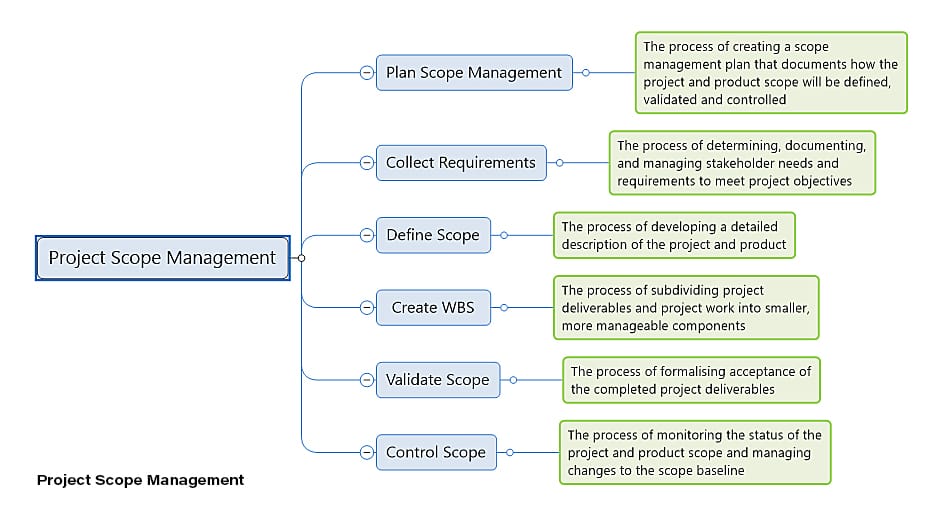
Download this Project Planning mind map in MindGenius
The processes involved in Project Scope Management are:
Plan Scope Management:
The first step is creating the scope management plan which will document how the project scope will be defined and will include detail on how this will be defined, validated and controlled throughout the lifetime of the project. The scope management plan includes the processes for how the project scope statement and WBS will be prepared and how the project baseline will be agreed and approved.
Collect Requirements:
The process of gathering all of the requirements of the project forms a key element of project scope management and should be an in-depth discovery exercise which involves collating the thoughts of all stakeholders on what their expectations are of the project outcome. The result of this exercise is a full list of all requirements for the project.
There are various means by which the requirements gathering can be carried out and these include:
- Interviews
- Focus Groups
- Facilitated Workshops / Meetings
- Questionnaires / Surveys
- Brainstorming Sessions
Once the requirements are gathered, they need to be collated, analysed and should be fully understood as to what each point means. The requirements list will feed into the creation of the project scope statement and the work breakdown structure. Not all requirements identified at this stage will be included in the project.
Define Scope:
The results of the requirements gathering process will feed into defining the project scope. This includes a full and detailed description of the project and the agreed deliverables. The definition of the project scope will outline stakeholder requirements and expectations and the work that will be required to meet that output.
The benefit of this detailed description of the project scope is that there is clear agreement on what the project includes and doesn’t include and also the acceptance criteria set out by the stakeholders.
The output of the define scope process is the Project Scope Statement which is the detailed description of the project, the deliverables, any assumptions made and any constraints surrounding the project. Importantly, as well as detailing what is involved in the project, the scope statement will detail what is not included. This agreement sets expectations for all stakeholders on what will not be delivered to avoid any confusion on completion of a project phase or the project itself.
The project acceptance criteria will be detailed in the project scope statement. Again, this avoids any confusion for the project team on what will be accepted by the stakeholders as deliverables of the project. Everyone knows clearly from the outset what is expected of them.
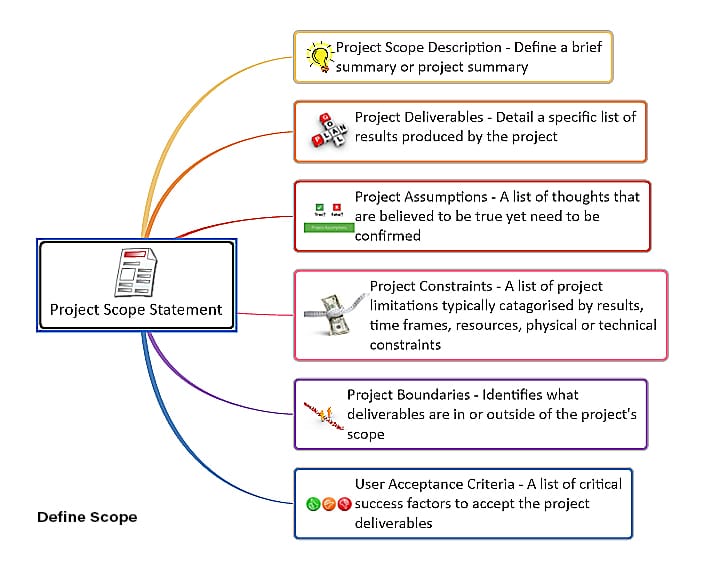
Download this Project Execution mind map in MindGenius
Create Work Breakdown Structure (WBS):
The work breakdown structure or WBS is an important part of project scope management. It enables the project manager to breakdown the high level scope statement into manageable work packages which will deliver the agreed deliverables of the project. The overall project can be broken down from the title to groups of work and then further into individual pieces of work within each of those groups.
A good example is the construction of a garden shed. You would start with the project title of Build Garden Shed and then work down to the deliverables or work packages of foundations, build, internals and electrics. Under each of those there would be level 2 and 3 work packages. The image below shows this all broken down to each level. Within the WBS you can also assign costs to each work unit and roll them up to each level and ultimately to the overall project cost.
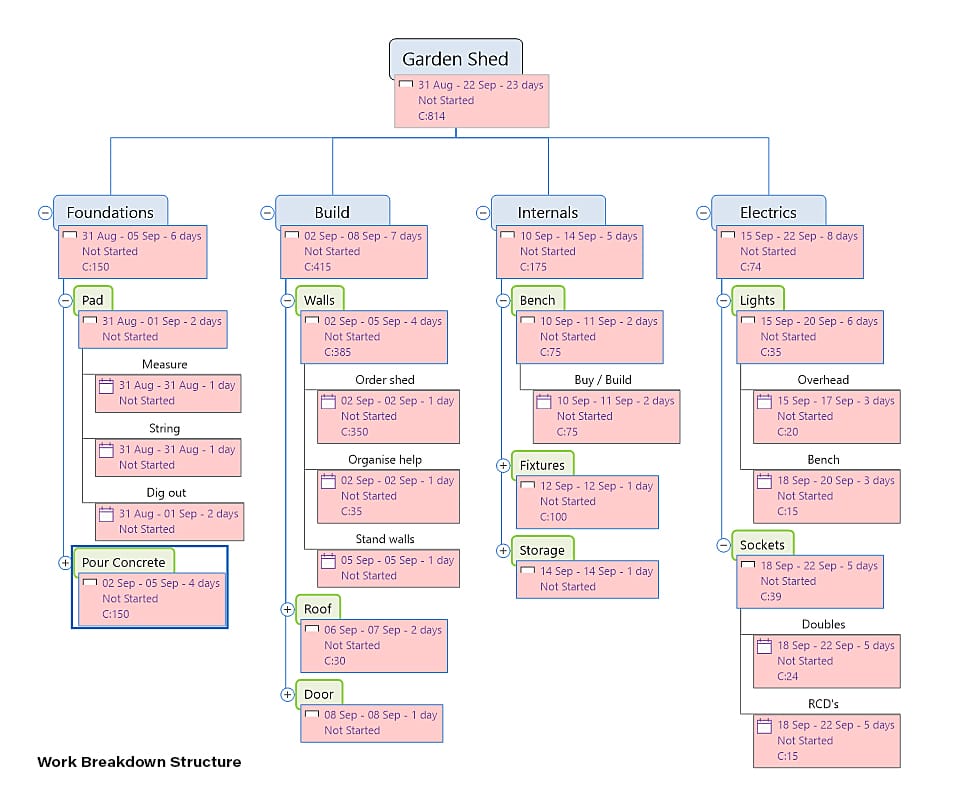
The work breakdown structure effectively takes the project scope statement, breaks it down into work packages and creates a framework for how the project will be delivered. Once the scope statement and WBS are prepared and agreed, they form the project scope baseline which is set for the project.
Validate Scope:
The validation of a project scope is the point at which the customer, requester of the project, product or service accepts what is laid out in the scope definition or project scope statement. This will result in formal acceptance of each deliverable.
This formal acceptance will occur at the end of each phase of a project. Agreement at this stage means there is a higher likelihood of the final deliverables being accepted at each phase completion and the end of the project.
Control Scope:
Once scope is agreed and the project kicks off, the scope needs to be controlled throughout the delivery process. This involves monitoring the work during the project to ensure it is meeting the agreed scope. This will also involve managing project change requests and the impact they will have on the scope baseline.
Controlling scope is essential to avoid scope creep. Without a formal change control process in place, timescales and costs can get out of hand quickly.
Back to Knowledge Areas Menu
3. Schedule Management
Project schedule management is the process of taking the work breakdown packages and applying timescales to these to determine the time it will take to complete the project. Each piece of work or task required to complete the project requires a start date, an end date and a duration. At this point, task dependencies will need to be taken into account to determine the critical path of the project.
Schedule management also includes detail on the processes that will be put in place to monitor and control the schedule throughout the life of the project.
The project schedule produced as a result of the schedule management process is essentially the detail on how the project will meet the expected deliverables of the project.
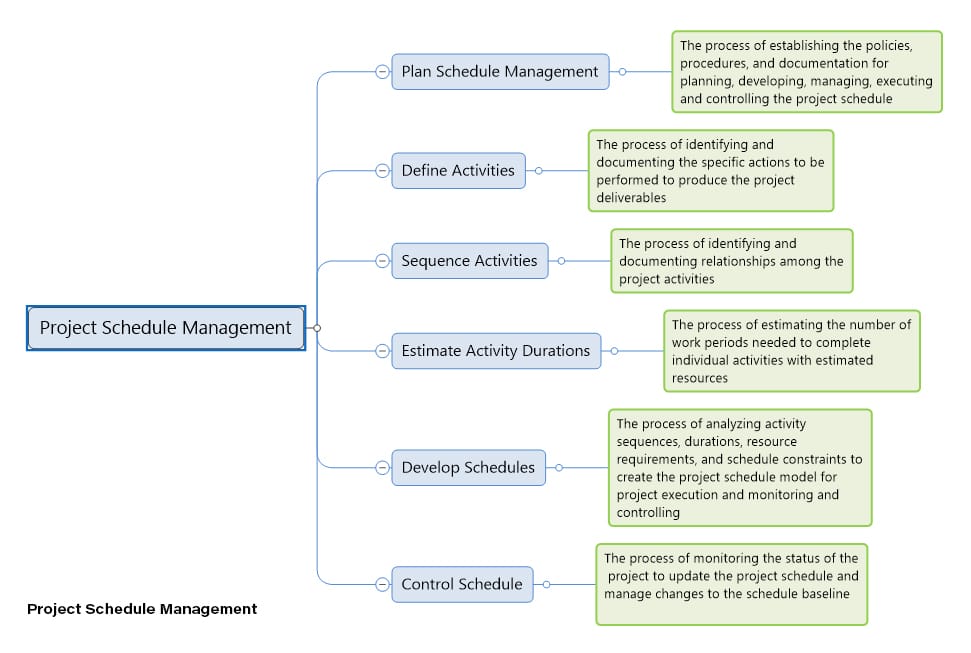
Download this Project Planning mind map in MindGenius
Plan Schedule Management:
Plan schedule management is the process that sets out how the project schedule will be planned, managed and controlled throughout the project. This offers clarity on how the schedule will be managed. The result of this process is the Project Schedule Management Plan. The plan can be very detailed or at a high level – this depends on the size and scale of the project and the needs of the stakeholders.
Define Activities:
The process of defining project activities provides the project manager and team with a list of everything that will be required to meet the agreed deliverables. The result will be a task list of everything that needs to be done to complete the project. This is done by taking each of the high level work packages and breaking them down into individual tasks.
Sequence Activities:
Once the full list of activities has been defined, they need to be organised into a sequence of order – what needs to be done first and what tasks are dependent on others finishing before they can even be started.
Estimate Activity Durations:
With activity sequencing complete, estimations of timescales need to be applied to all activities to be able to build the project plan. Each task / activity needs to be considered in turn and timescales applied to them. This will provide an estimation of the total project duration.
There are a number of techniques which can be used to do this. The Project Management Institute recommend the following as possible techniques but this can be done in any way which suits the project, it’s size and the individual organisation:
- Analogous estimating
- Parametric estimating
- Three point estimating
- Bottom up estimating
- Data analysis
- Decision making
- Meetings
Develop Schedule:
Developing a project schedule is the process of building the actual project plan which will be followed to deliver the project and will be the baseline used for monitoring and control purposes. To build the schedule, the project manager will consider the activities, the sequencing of activities, the estimated durations and the resources that will be required and what resources are actually available.
With all of that information the schedule can be developed and the project schedule and baseline can be produced. This will also highlight the critical path of the project – this highlights the tasks and activities which show the longest path through the project.
Control Schedule:
The control schedule phase kicks in once the project has started. This is where the project manager monitors progress of work compared against the original project baseline. Throughout the project, there will be updates on performance of work as well as any revisions to the schedule forecasts.
Any change requests will also be managed and the schedule baseline updated accordingly for all approved change requests.
4. Cost Management
The project cost management process involves applying estimates on all costs involved in the project. This will also include plans for how costs will be managed and controlled throughout the project.
The project scope definition is crucial in feeding into cost management, the more accurate the scope is, the more accurate the cost estimates and budgeting will be.
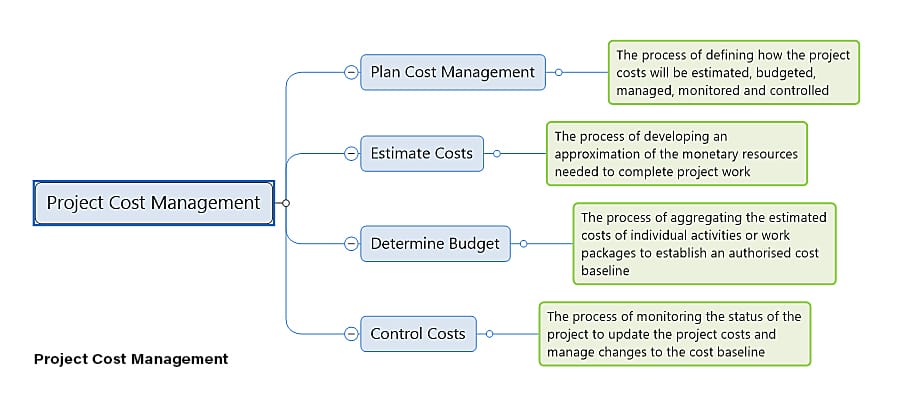
Download this Project Planning mind map in MindGenius
Plan Cost Management:
In planning cost management the project manager will outline how costs will be estimated, budgeted, managed, monitored and controlled. Cost planning will consider all potential costs involved in a project, including resources, materials, tools and equipment.
The plan cost management process will detail how much money will be required at each phase of the project.
The result of this process will be the Cost Management Plan.
Estimate Costs:
Project cost estimates provide the project manager and stakeholders with a view on what the expected costs of the project will be. This enables them to agree a budget for the overall project. To prepare the cost estimate, all resources will be assigned and expected cost. This includes labour, materials, equipment, services and facilities. Consideration will also be given to inflation and any costs associated with the financing of the project.
There are a number of estimation techniques that can be used for this exercise and how the cost estimates are determined will be guided by the scale of the project and the organisation involved. Some cost estimation techniques are:
- Expert judgement
- Analogous estimating
- Parametric estimating
- Bottom up estimating
- Three point estimating
- Data analysis
- Project management information system
- Decision making
- Accurate cost estimating is a crucial part of project planning to feed into budget approvals. Further reading on cost estimation can be found in the blog – The Ultimate Guide to Project Estimation.
Determine Budget:
The results of the cost estimating exercises will determine the overall budget for the project. The project scope baseline and the project schedule will also feed into this process. The agreed budget for the project will become the basis for project cost control throughout the project. The approved budget is the funding for the project and shows what the stakeholders have agreed to and if the funding will be released in phases as the project progresses or reaches key milestones.
Control Costs:
Project cost control is just as important to a successful project as completing on time and to the agreed scope. The process of cost control involves keeping track of all actual costs in comparison to the agreed budget and the initial project cost baseline.
In addition to simply tracking actual spend against the cost baseline, the project manager needs to take into account potential risks which will impact on the overall costs of the project. Any expected increases in budget to what was originally agreed should be managed to try and bring them back into line with the agreed budget and at least to within acceptable limits. Any significant changes to the agreed budget need to be managed via change control requests and approval re-confirmed.
Managing project costs should be done for each phase, for the components broken down in the WBS and for the overall project.
Back to Knowledge Areas Menu
5. Quality Management
The success of a project will depend greatly on the quality of the goods or services produced and handed over on completion. These need to meet the quality expected by the stakeholders at the outset. It won’t matter if the project is completed on time and within budget if the quality does not stand up to what was expected and agreed when the project was kicked off.
Quality assurance and control must be continued throughout the project to ensure quality standards are being met.
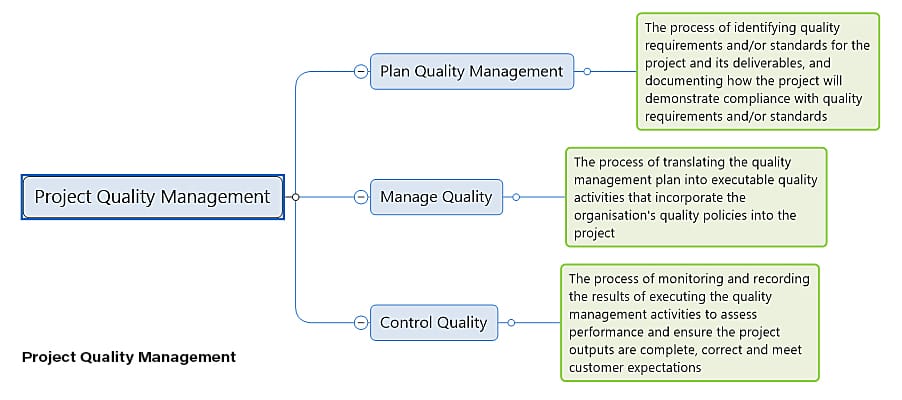
Download this Project Planning mind map in MindGenius
Plan Quality Management:
Plan quality management is the process by which the team will measure and manage quality throughout the project.
Quality planning isn’t done in isolation but is carried out alongside the other planning activities. To determine quality standards and how they will be managed, the project manager will need to consider the project scope, the resources available and the agreed project budget. These elements all work together when creating the project plan. For example, any changes to cost or scope will impact on the deliverables of the project and ultimately the quality as a result.
During planning, the project manager and team will consider how they will test and measure the quality of the goods or services throughout the project lifecycle to meet expectations. How this testing will be done will be documented as part of the quality planning process.
The output of planning quality management will be the Quality Management Plan which is a component of the overall Project Management Plan.
Manage Quality:
Managing quality throughout a project is the process of carrying out the processes, tests and measurements as set out in the Quality Management Plan. In effect this turns the plan into activities which will be carried out at various stages of delivery.
Ensuring quality standards are met is the responsibility of everyone involved in the project.
Control Quality:
The extension of managing quality is controlling quality. This is the process of carrying out the activities for managing quality and recording the results. Where expectations are not being met, there will be a process for raising non-conformance and change requests for re-work and improvements. This may then impact on the project timescales and budget.
Back to Knowledge Areas Menu
6. Resource Management
Project resource management is the process of ensuring there is a team in place to carry out the activities required to carry out the project activities.
When building the project plan, the project manager would outline what roles would be required within the team at any given time throughout the project. Based on these the project team would be built. This includes determining whether the skill sets required are readily available and whether new hires will be needed either for the term of the project or permanently and also if any existing staff will need training on any area.
Team management will be ongoing throughout the project and is the project manager’s responsibility. They need to monitor team members individually to ensure their work is being carried out as requested and if they need help or training. They also need to ensure there are no issues among the team and that everyone is working well together to meet the deliverables of the project.
Sometimes, the full project team will not be based in the same location, resource management needs to take this into account and manage how remote teams will work.
Resource management is not limited to the members of the project team. The resource management process covers all resources that will be required – people, materials, services and equipment.
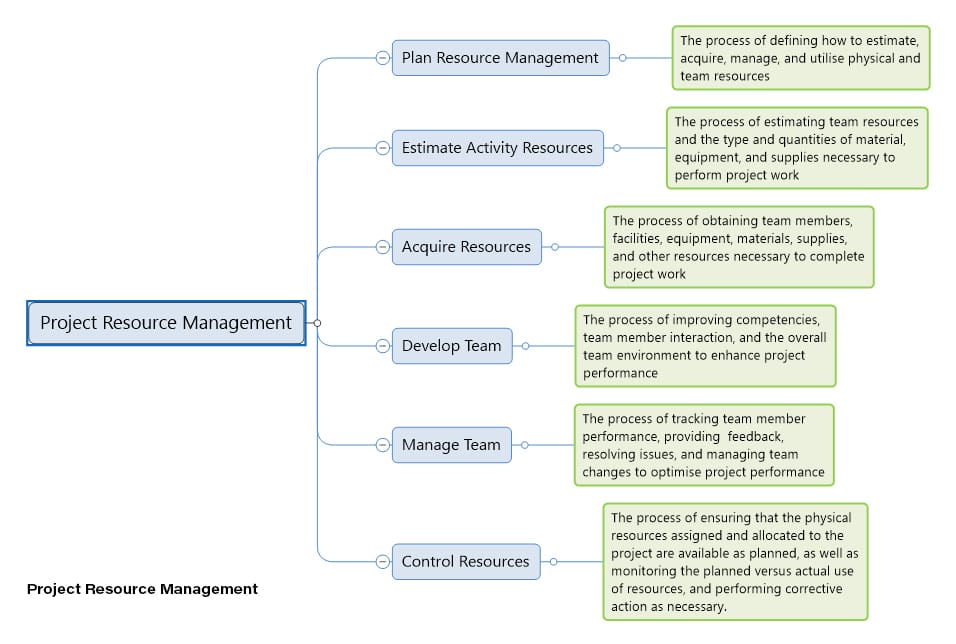
Download this Project Planning mind map in MindGenius
Plan Resource Management:
Plan resource management will happen in conjunction with the other project planning activities. This process involves establishing who the team will be, when each team member will be required and also how they will be managed throughout the project.
The resource plan will include plans for material and equipment hire if required and at what point in the project these will be needed. If the project involves building something, the resource plan will include plans for ensuring the necessary materials are in place when needed. There is no point having the team member ready to carry out the work if the materials aren’t in place to let them carry out the work.
The plan resource management process will produce the Resource Management Plan which forms part of the overall project management plan.
Estimate Activity Resources:
Estimating activity resources is the process of quantifying the resources required to complete the individual activities that will deliver the project. The project scope baseline will be used to determine how many people will be needed to deliver the project, what their roles will be, what materials will be needed and when they will need to be available, any equipment that will need to be purchased or hired and when it will need to be available.
A resource breakdown structure can be completed to detail labour, materials, equipment etc. and will show quantities and then timings they will be needed throughout the project.
Acquire Resources:
Once all resources required has been calculated and the resource plan complete, the project manager can move onto actually acquiring the resources that have been identified as being needed.
For people, this will be either internally assigning people to a project or hiring for new employees to carry out the work required.
There will also be a process of acquiring the material and equipment resources needed. This will involve identifying where these will be sourced from. In large organisations there will likely be procurement agreements in place with preferred suppliers for these and in smaller organisations it could be down to the project manager or a member of the team to source where these will come from.
In acquiring resources, there are a number of project planning elements that will need to be considered. The resource management plan to determine when things are needed and the cost baseline to make sure costs are controlled when sourcing external resources.
With all resources in place and a plan for when resources will be brought in throughout the project, the work can begin.
Develop Team:
A project won’t be a success if the project team doesn’t work well together. The task of developing the team falls to the project manager who needs to ensure that everyone knows what is expected of them in terms of work including quality and timescales.
This process also needs to ensure that the team members are fully trained in the tasks they are being asked to do and making sure they get training and help where needed.
Unfortunately, with the best will in the world, not all teams will get along and team development involves making sure any issues are addressed to ensure they do not impact on moral and on the overall success of the project.
Developing the team will involve establishing how they will all work together during the project, this is especially important if the team are working remotely from each other.
Manage Team:
Once the team is established, ground rules have been established for how they will work together and the project has kicked off, it falls to the project manager to make sure the team is managed effectively.
This involves monitoring performance against the plan and providing feedback to ensure the project stays on plan.
Team management means being able to facilitate team work, communication and resolving issues when they arise. Ground rules can be set out for meetings, communication and decision making.
The project change request process will feed into team management as and when the team needs to change. Team members could change throughout a project for any number of reasons – the individual being needed elsewhere in the business or that someone leaves the organisation. Or this could arise if the scope of the project changes and as a result, different team members are required.
Control Resources:
All areas of the project management process require controls to be put in place and resource management is no different. Controlling resources in a project involves making sure the resources allocated – be it people, materials or equipment are available as and when needed and monitoring the reality against the plan. In monitoring and controlling resources, the project manager makes sure that resources are available and used when needed and released when they are no longer required. For example, there is no point in having a piece of equipment sitting idle and adding to costs when it is no longer needed.
7. Communications Management
All projects have a group of stakeholders who need to be kept up to date on the progress of the project. Project Communications Management is the process of making sure that happens either verbally, written or formal or informal.
This involves setting out and agreeing how the project manager and project team will communicate with the stakeholders and then the actual activities of communicating and reporting throughout the project.

Download this Project Planning mind map in MindGenius
Plan Communication Management:
A simple communications plan will outline:
- Who will you communicate to during the project – for example, stakeholders or a management team
- The subject of the communications – for example, status reports
- Frequency and timings of communications – for example, weekly or monthly or at specific phases of the project and will these reports be at a specific time?
- What format will the communications be in? – for example, meetings, presentations or written reports or a combination of these
A more detailed communication plan will include all of the above information and additionally will set out the names of all stakeholders, their area of responsibility on the project and their contact information. This will be further developed to detail each of their individual requirements from communications – i.e. what do they need to know, in what format and when.
The project communications plan will set the guidelines for communicating and reporting activities throughout the life cycle of the project.
Manage Communications:
Managing communications during a project is the process of taking the requirements of the communication plan and carrying out the tasks required to meet those requirements. This involves gathering all of the information required and ensuring that information is delivered to the right people at the right time. A good way to set the scene for this is with the Project Kick Off Meeting where the ground rules for project communication can be set out and agreed.
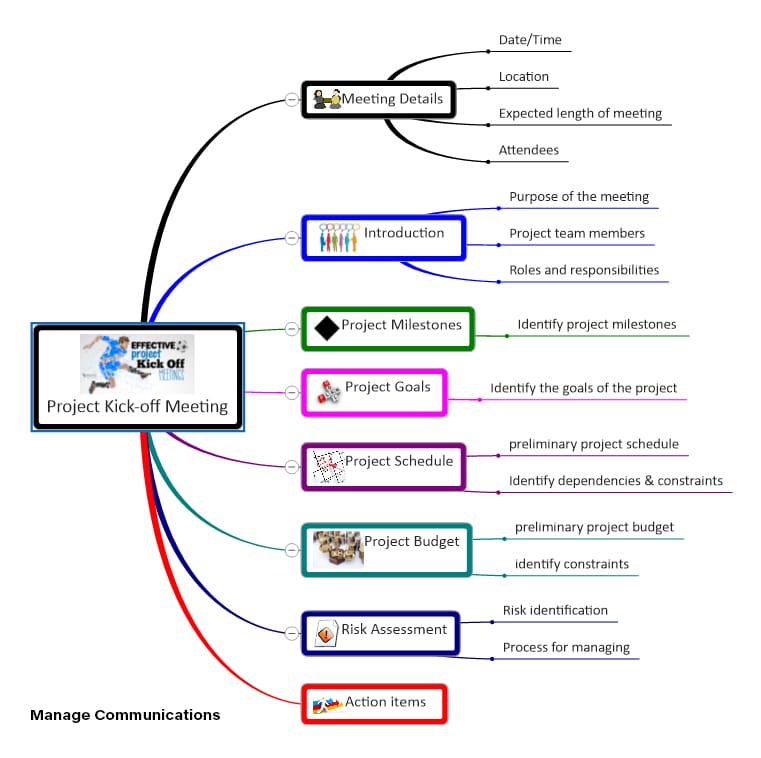
Download this Project Planning mind map in MindGenius
In addition to the planned communications, this will also involve the reporting of any change requests or problems arising in the delivery of the project, ensuring any problems are escalated in a timely manner and not ignored until they become a bigger problem.
Monitor Communications:
The communications process also needs controls in place and this is simply to ensure the needs of each stakeholder are being met. This involves monitoring that all communications are going to the right people, at the right time and with the required and relevant information that they need.
This monitoring process also ensures that the information being shared means the stakeholders maintain an interest in the project and still support it’s existence. Effective project communications mean ensuring that the right information is in front of the right people at the right time.
There are various methods of monitoring this, including:
- Surveys
- Lessons learned exercises
- Observations of team members on stakeholder engagement
- Retrospective Meetings
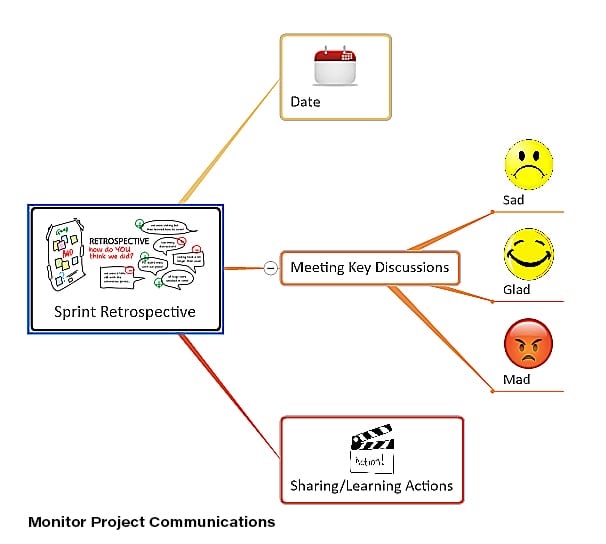
Download this Project Planning mind map in MindGenius
Back to Knowledge Areas Menu
8. Risk Management
Managing risk in a project is essential to ensure potential scenarios of issues have been identified, thought through, mitigated and planned for to make sure if they do occur there is minimal impact on the project.
There are five key areas that need to be addressed in risk management:
- Identify the risk
- Analyse the risk
- Evaluate or rank the risk
- Treat the risk
- Monitor and review the risk
The process of risk management is designed to decrease the risk of uncertainty. This needs to be carried out to increase the chances of a project’s success.

Download this Project Planning mind map in MindGenius
Plan Risk Management:
Plan risk management outlines the approach the project team will take to risk management. This is proportionate to the size and scale of the project and will outline the techniques that will be used to identify, mitigate and manage risk to the project. The approach and attitude to risk will be determined by the size of the project, the organisation’s approach to risk and the importance of the project the organisation. For example, a crucial project will have a more detailed approach to the risk.
The outcome of planning will be the risk management plan which will outline the risk strategy, the roles and responsibilities of the risk management team and any costs associated with risk management.
The plan will also include the risk register, how risk management will be reported and how it will be monitored and tracked throughout the project.
A good tool to utilise during this process is our Red Flag Management Mind Map:
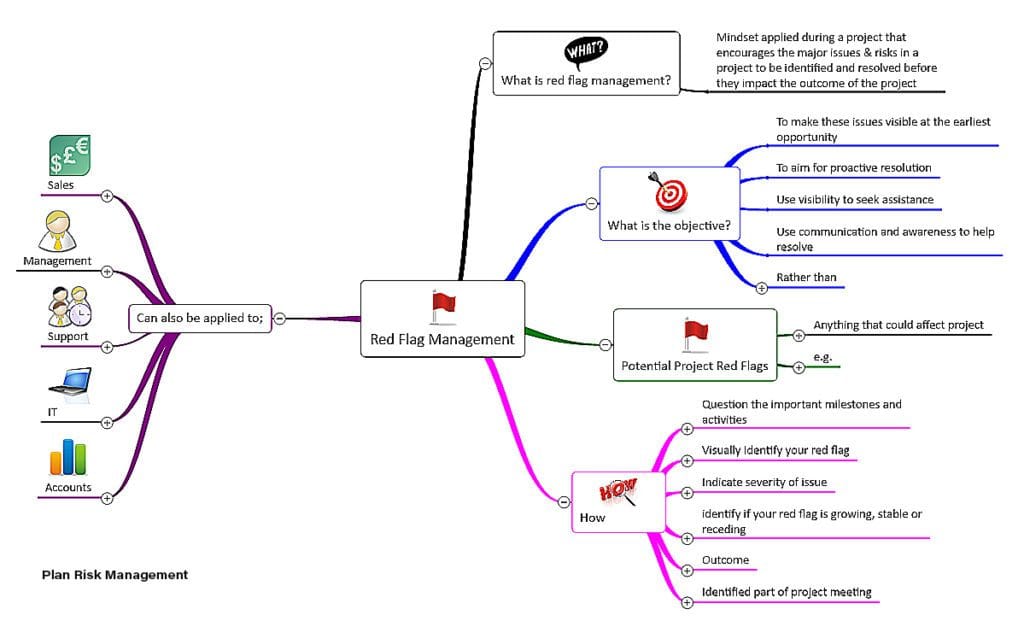
Download this Project Planning mind map in MindGenius
Identify Risks:
Before risk management can begin, potential risks need to be identified. This involves input from anyone who may have knowledge of potential risks to elements of project work or phases as well as the overall project deliverables.
There are a number of tools and techniques which can be used to identify and analyse a list of potential risks.
For data gathering, these include:
- Interviews
- Brainstorming
- Checklists
The results can then be analysed using:
- Root cause analysis
- Assumption and
- constraint analysis
- SWOT analysis
- Document analysis
Identifying risks should be performed early in the project to ensure risk management activities can take place.
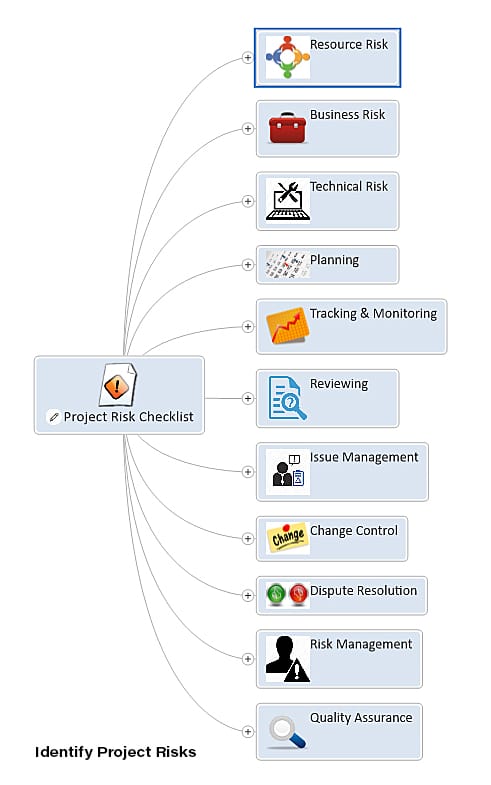
Download this Project Planning mind map in MindGenius
Back to Knowledge Areas Menu
Perform Qualitative Risk Analysis:
A qualitative risk analysis will take a specific risk and drill into this for a more detailed analysis, assessing the probability of occurrence against the overall impact on the project if the risk did occur. The impact of a risk occurring will usually effect some or all of the project elements – schedule, budget, resources, deliverables, costs, quality, scope, and performance.
During the qualitative risk analysis, a risk owner will be identified and assigned to each risk – this person is responsible for preparing the risk response.
Perform Quantitative Risk Analysis:
Quantitative risk analysis is a deeper analysis of the highest priority risks and assigns a numerical or quantitative rating to the risk in order to develop a probability of the risk occurring and the impact it will have on the project. Not all projects will involve quantitative risk analysis as this type of analysis is reliant on quality data being available on individual risks.
Plan Risk Responses:
Planning risk responses is the process of detailing what the response would be to each individual risk if the event did occur. Risk responses are designed to minimise the threat or impact to the project if the risk occurred.
Risk responses can be categorised as:
- Escalate – where the risk can’t be managed by the project team, it will be escalated to a higher level or another department
- Avoid – the response details how to eliminate the cause
- Transfer – some risks can be deemed to be the responsibility of a third party and as such cannot be managed by the project team
- Mitigate – the team put steps in place to minimise the impact of the risk
- Accept – acceptance means the team have decided they can’t put mitigation plans in place in advance but if the risk should occur they will have contingency plans in place to manage the impact. If a risk is being accepted, it should be communicated to all stakeholders.
Implement Risk Responses:
Once the risk response plans are agreed, they are then implemented. It is important to make sure this stage happens with tasks and activities in place to manage this process. Too often, project teams take the time to do all of the work of planning for risk, identifying and analysing the risk and detailing the risk responses in the risk register only to not actually carry out any of the activities required to ensure the risks don’t impact on the project.
Monitor Risks:
The process of monitoring risks is ensuring the risk responses that were identified are then implemented throughout the project.
This also includes making sure that any new risks identified during the project are also managed in the same way and that the risk management that has been carried out and put in place is effective and does not need to be revisited and improved as the project progresses.
Risk monitoring is the process of ensuring that any controls that have been put in place are effective and taking the corrective action if they are not working.
Back to Knowledge Areas Menu
9. Procurement Management
Project procurement management is the process of how purchased for external resources will be managed throughout the project. This will include documenting any purchasing processes that are already in place and will be followed or any supplier or contract agreements that are in place and will be followed throughout the project. This will also detail who is authorised to make and approve purchased and how these will be managed and controlled during the project.
Plan Procurement Management:
Planning procurement management is the detailing of what has been agreed / approved to purchase and the process for how this will happen, including what to purchase and when it will be needed. This will include list of potential suppliers and details on any supplier agreements. The project schedule will feed into the procurement process to guide what is required and when.
Roles and responsibilities in terms of procurement will be outlined as part of this plan. The level of procurement experience required will depend on the scale of the project. In smaller teams it is likely that procurement will be handled by one of the team members and larger scale projects and organisations will usually have a purchasing department and will assign someone to the project team from that department to manage the project procurement process.
Whoever is responsible for the procurement process will manage suppliers, agreement and contract negotiations.
The result of the plan procurement process is the Procurement Management Plan.

Download this Project Planning mind map in MindGenius
Conduct Procurements:
Conducting procurements is the actual act of securing a supplier and placing the order. This could be as simple as selecting a supplier from a preferred list and placing an order or a full process of requesting buds from a number of suppliers, evaluating the response and selecting who to place the order with.
Control Procurements:
In line with cost control, the procurement process needs to be controlled and monitored throughout the project.
This process involves monitoring that supplier agreements are fulfilled in line with contracts, goods and services are delivered when agreed and that the quality of what is received meets the terms of the agreement. Performance reviews of all these elements should be an ongoing process during project delivery.
Back to Knowledge Areas Menu
10. Stakeholder Management
Stakeholder management is an important part of any project. This process involves identifying people, groups and organisations who will be impacted by the delivery of the project. This goes further to ensure, that once identified, stakeholders remain engaged in the project throughout it’s life cycle – this means ensuring they are kept up to date on progress and key milestones / phases of the project and are included in decision making throughout. Managing stakeholder expectations is a critical role for the project manager.

Download this Project Planning mind map in MindGenius
Identify Stakeholders:
The first step in stakeholder management is to identify who the stakeholders are. In doing so, the project manager compiles a list of people, their role, their interest in the project, the impact project deliverables will have on them and outline their approach to communicating with them and maintaining their interest and engagement throughout the project.
Stakeholders will have varying degrees of influence over the outcome of the project and will also have different levels of interest or are more interested in certain phases of the project, this should be taken into account when identifying stakeholders.
A stakeholder register will be produced from this.
Plan Stakeholder Engagement:
The first step in stakeholder management is to identify who the stakeholders are. In doing so, the project manager compiles a list of people, their role, their interest in the project, the impact project deliverables will have on them and outline their approach to communicating with them and maintaining their interest and engagement throughout the project.
Stakeholders will have varying degrees of influence over the outcome of the project and will also have different levels of interest or are more interested in certain phases of the project, this should be taken into account when identifying stakeholders.
A stakeholder register will be produced from this.
Manage Stakeholder Engagement:
Once identified, stakeholders need to be managed throughout the project. This process ensures the stakeholder engagement plan is being implemented as outlined.
At this point, the project manager is responsible for ensuring communications are ongoing as planned and that expectations are being managed. Key skills at this point include being able to communicate clearly, manage any conflict that arises and negotiate any changes in expectations as the project progresses.
This process is about making sure the stakeholders are still engaged in the project and that their expectations on deliverables have not changed from the original scope, cost and schedule agreements.
Monitor Stakeholder Engagement:
Monitoring stakeholder engagement is the process of making sure the stakeholder engagement plan is effective in terms of communication and keeping stakeholders engaged. If this is not the case, modification to the plan will take place to adapt to what is required.
Back to Knowledge Areas Menu
Summary
The PMI PMBOK Guide, 6th edition provides a framework for managing any project, regardless of size. At MindGenius, we have taken the PMBOK Guide and prepared some templates to help you with each element of the guide. These are downloadable throughout our guide.
In addition to this framework for managing projects, there are a number of project management methodologies which can be followed. Each one has it’s own merits and which one to choose depends on the organisation, the project itself and what will suit the way the project team works.
The next section of our guide will look into these in more detail.
